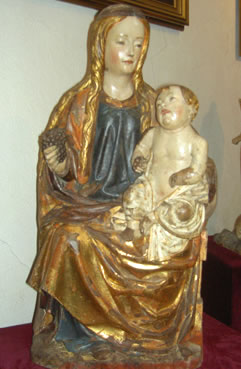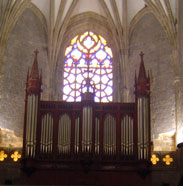The parroquial church holds the title of Basilica given by Pope Leon XII in 1884, and it shows still today most of the architectural and iconographic richness. Gospel Side
In the entrance area there is a lean against the wall tomb [Arteyta Family, Inigo Arteyta First Spanish squad admiral, historical connection with Columbus and the conquer of the kingdom of Granada, around 1500], beside The Garden of Gethsemane, Easter procession float. Immaculate Virgin image, polychromatic wood, baroque XVIII Century. Our Lady of Carmel retable.
|
  |
On the left side, a sitting Madonna with a grape, beginning of the 16th, Marie Magdalene, St. John the Bathist, couple of painting as ''The Running to Egypt''
And "The Dead of St. Joseph". On the opposite side, a Madonna in white marble, made in 1856, by French sculptor Toussaint, two tombstones in bronze, [also Spanish Flemish] and an image of the Trinity, English medieval alabaster piece placed in the centre.
The Chapel of the Holy Cross keeps the legendary image of the Crucified Christ, the Sleeping Christ, the Pietate, all Eastern Procession floats. Also in this chapel two sepulchres. - On the wall, Inigo Loperena [1747-1762] also named "Lekeitio's little Gentleman". On the floor, Resurreccion Maria de Azcue [1864-1951] priest, writer, musician, founder of the Basque language Academy [Euskal-itzas-zaindia].
 |
In 1853 Aristides Cavaille-Coll presented to Lekeitios’Town-Hall the Project o fan organ with manual 2 keyboards of 54 notes, a 30 notes pedal and 22 registers.
The cost was 2000 franks.
A Parisian banker born in Lekeitio, Jose Javier Uribarren, bought this organ for the basilica of his natal Villa. As such important organ required to be attended by and organ-player with studies, he offered to pay them, and Juan Mari Blas de Altuna was the chosen one, known in our Basque History as a collaborator of Iparraguirre in the composition of the, well known among the Basque, song "Gernikako Arbola".
In 1930, it was added two more registers to the pedal for pneumatic extension.
This is the first Romantic organ piece piece known in the Basque and Spanish land.
Since 1988, the official organ-player of the basilica is Aitor Olea Juaristi, 1995 title of piano professor in Juan Crisostomo Arriaga Conservatoire, Bilbao. Gold medal and Scylla reward in the ENM of Bayonne where in 1997 finished his organ studies.
2001, Honor mention and title of organ professor in the Jesus Guridi Conservatoire, Vitoria. Has offered concerts in France, Germany, England and Italy. Participate in different well known organ festivals San Sebastian, Alava, Guipuzcoa and is the master organizer of International Organ Festival of Lea-Artibai.
| © BasÃlica de Lekeitio. C/ Abaroa s/n. 48280. Lekeitio. Bizkaia. | Powered by Bajoelagua Factory |